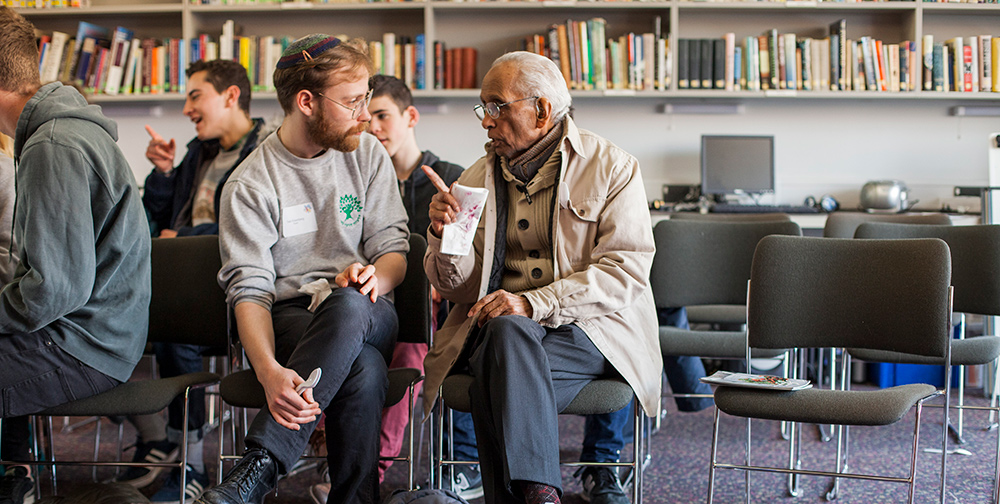Can we constitute a minyan online?

There are many prayers that need to be recited in a minyan – a group of ten people. The Mishnah in Tractate Megillah states:
They do not recite the Shema responsively, And they do not pass before the ark (Recite the Amidah); And they (the priests) do not lift up their hands (Priestly blessing); And they do not read the Torah (publicly); And they do not conclude with a haftarah from the prophets; And they do not make stops (at funeral) processions; And they do not say the blessing for mourners, or the comfort of mourners, or the blessing of bridegrooms; And they do not mention God’s name in the invitation (to say Birkat Hamazon); Except in the presence of ten. (Mishna, Meg. 4:3)
Various explanations have been given for the requirement of having a minyan. Perhaps best known is the idea that these are communal obligations and therefore need to be recited in a community. Ten is the minimum number of people to be considered a community.
Another explanation is that these are Holy Activities – Devarim She-ba-Kedusha – and need to be done in God’s presence. God’s presence is guaranteed wherever ten people collect together, as it is written ‘And I shall be hallowed among the children of Israel’. (Lev 22:32)
If ten people need to come together for a minyan, what is the meaning of ‘together’? How close to you need to be in order to count?
The Shulchan Aruch rules: All of the ten need to be in one place and the prayer leader with them. (OC, 55:13). The Poskim (Halachic decisors) have debated many different configurations over the years: If you are outside of the building behind a glass wall and you can see and hear the service – does it count? (Yes) If you are in a different room that opens up onto the room where the prayer is being said – do you count? (No) If the prayer leader stands in the doorway between the two rooms – do both rooms count as being the same space? (Yes). The common denominator is that being in the same place means being able to see at least some of the other participants in the prayer service. So physical proximity is essential.
If the definition of a minyan is ten people together in the same space, is there room to broaden the definition to include being in the same social or spiritual space? Particularly, in the case of a digital medium where participants not only hear each other, but can also see each other, albeit only on screen?
Again, most Poskim have determined that minyan cannot be constituted this way; that physical proximity is the central definition of community. But, while a virtual Minyan doesn’t count as being fully a minyan, many would agree that a virtual minyan does have value, and that there are many important parts of the service that can be recited in a virtual Minyan.
The Mishnah above lists the parts of the service that require a properly constituted minyan. There are other parts of the service where we customarily require a minyan to be present – but aren’t included on this list. Thus, repeating the Amidah, reciting the Kedushah (in the repetitio), the Priestly blessing, Public Torah reading and reading the Haftorah with the blessings all require a minyan of ten in the same space.
Where the obligation for a minyan is an established custom rather than a legal requirement, a virtual minyan should be acceptable. What are the things for which a virtual minyan would be sufficient?
Kaddish: The kaddish is a traditional praise of God, recited by the mourner after the prayer service. Given the emotional importance of reciting Kaddish for many people and the fact that it is a custom rather than a legal obligation, there are many rabbinic precedents for being lenient on the halachic requirements for reciting Kaddish. Therefore, Kaddish can (and should) be recited in a virtual minyan.
Torah Reading: While a communal reading which entails reading from a scroll, calling up seven people and reciting the blessings requires a Minyan, one can always read and study the Torah, whether alone or in a group.
Haftarah: As above. It can be read at any time, but without the blessings for a communal reading.
Ultimately, a minyan is two things: it represents a physical community and it is a spiritual place where God’s presence resides. In an ideal world, both of these things come together. But where this isn’t possible, there are many ways we create communities. Our virtual communities should allow us to create a spiritual space where we can welcome God’s presence and recite together many of our communal prayers. Still, without close proximity, our communities are incomplete. Saying some, but not all, of our communal prayers reflects this reality.
May it be God’s will that the current threat will pass, and we will soon return to the full spectrum of communal activities and prayers.
Rabbi Chaim Weiner is Av Bet Din of the European Masorti Bet Din




